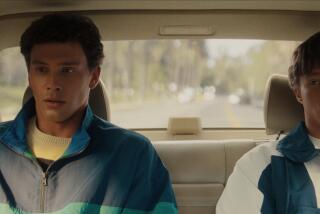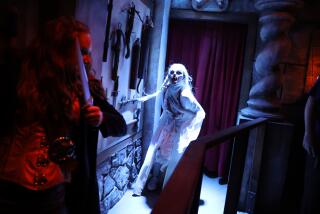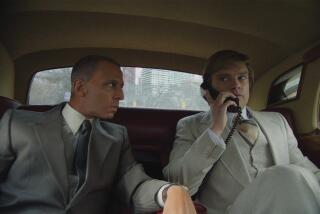MOVIE REVIEW : TOO MANY MOTIFS FOR JUST ONE ‘BRIDE’
As its truncated title coyly suggests, we’re not supposed to think of “The Bride” (“of Frankenstein”) as a horror picture. Sure enough, it turns out to be a valiant attempt at full-blown Gothic romance, with contemporary feminist overtones and only the slightest ties to James Whale’s 1935 classic of the full name.
Unfortunately, for all the admirable respect director Franc Roddam and writer Lloyd Fonvielle (who co-wrote Roddam’s “The Lords of Discipline”) bring to their extensive reworking of the legend of Frankenstein and his bride, they’re over their heads--waaaaayyy over. The result is a film that commands affection for its ambition and civilized sensibility, but nonetheless provokes unintended laughter.
Amid great peals of thunder and flashes of lightning, Baron Frankenstein (Sting) prepares to lower a giant lightning rod to an immense glass ball crackling over a woman wrapped like a mummy and lying in a sling. Lightning strikes, and voila : a bride for Frankenstein’s hulking, lonely monster (Clancy Brown). She turns out to be the gorgeous Jennifer Beals, but is terrified of the Monster, so the Baron refuses to turn her over to him. In his rage, the Monster destroys the Baron’s stone tower laboratory.
At this point the film splits into two intercut stories. In one, the Baron begins a Pygmalion relationship with Beals, whom he calls Eva (as Adam and Eve). He sees “The Wild Child”-like tabula rasa she presents as a chance to create a “free” woman who would be the equal of man. But he insists that she bend to his will at all times and in all matters (after all, it is 1830).
In the second story, the Monster begins a lengthy odyssey, assisting the diminutive Rinaldo (David Rappaport) in his circus trapeze act. It’s as if “My Fair Lady” were interwoven with “Of Mice and Men,” culminating in “The Beauty and the Beast.” These and other familiar motifs prove too many for Roddam and Fonvielle to handle. While they attempt to tell both stories with a resolute and commendable absence of camp, when they inevitably converge, the film, having had no protective sense of humor of its own, lurches out of control and ludicrously over the top.
Serious problems of structure and pacing afflict the film from the start. No sooner are we on the verge of involvement with one of the stories than we’re switched to the other. The effect, compounded by deliberately languid pacing, is that “Bride” scarcely ever comes alive--except when Rappaport is on the screen. (Everyone else, including Geraldine Page, Quentin Crisp and Veruschka in tiny roles, is stuck having to be very, very earnest; there are moments when you wish Sting would break into song and Beals into dance just to liven things up.)
Rappaport, the leader of the dwarfs in “Time Bandits,” is so vital, resourceful and appealing as an actor that he makes his friendship with the Monster, whom he names Viktor, irresistibly touching. Perversely, his lovable character is out of the picture long before the end.
There are, alas, even more problems. For something like three-fourths of the film we’re left wondering why the Baron shows no concern for the fate of his Monster; finally, Sting has a line revealing that he believes the creature burned in the fire that destroyed the laboratory. What’s more, Sting is too young and charismatic to play a Henry Higgins-like mentor. If appearances were everything, “The Bride” (citywide) would have it made. With stupendous authentic locales (in France as well as England), lush costumes, rich color and an even more lush Maurice Jarre score, “The Bride” (rated PG-13; may be too intense for preteens, also some nudity) brings to mind the candle-lit “Barry Lyndon.” But too often, for all its elegance and tenderness, it seems like a series of still life paintings.
‘THE BRIDE’
A Columbia presentation. Executive producer Keith Addis. Producer Victor Drai. Director Franc Roddam. Screenplay Lloyd Fonvielle; based on characters created by Mary Wollstonecraft Shelley. Camera Stephen H. Burum. Music Maurice Jarre. Production designer Michael Seymour. Costumes Shirley Russell. Associate producer Lloyd Fonvielle. Stunt coordinator Gerry Crampton. Film editor Michael Ellis. With Sting, Jennifer Beals, Geraldine Page, Clancy Brown, Anthony Higgins, David Rappaport, Alexei Sayle, Phil Daniels, Veruschka, Quentin Crisp, Cary Elwes, Tim Spall.
Running time: 1 hour, 58 minutes.
MPAA-rated: PG-13 (some material may be too intense for children under 13).
More to Read
Only good movies
Get the Indie Focus newsletter, Mark Olsen's weekly guide to the world of cinema.
You may occasionally receive promotional content from the Los Angeles Times.










